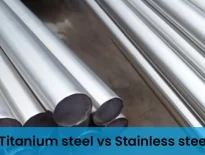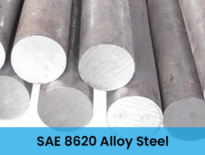What is Low-Alloy Steel?
Low-alloy steel is a type of steel that includes small amounts of additional metals to enhance its properties. Typically, these alloying elements make up between 1% and 5% of the steel’s composition. The purpose of these additions is to improve the steel’s mechanical qualities, such as strength and durability, and to help it resist corrosion. This type of steel is designed to offer better performance in various applications compared to plain carbon steel.
What is Low-Alloy Steel Used For?
Low-alloy steel is used in various industries due to its enhanced properties. It’s commonly found in:
- Pipes: Used in oil and gas pipelines.
- Automobile and Jet Engine Parts: Chosen for its strength and durability.
- Rail Lines: Provides the toughness needed for heavy loads.
- Structural Engineering: Applied in both onshore and offshore structures for added resilience.
The alloying elements in low-alloy steel, such as carbon (C), manganese (Mn), chromium (Cr), nickel (Ni), molybdenum (Mo), vanadium (V), and silicon (Si), usually make up less than 10% of the steel. Accurate analysis of these elements is crucial for ensuring quality and maintaining competitiveness in the market.
High-strength, low-alloy (HSLA) steel, a subset of low-alloy steel, is designed to meet specific mechanical requirements. It’s used in applications like warships, structural steel, and heavy machinery.
Steel grades such as ASTM A514, A517, and T1 are treated to enhance strength and toughness, making them suitable for heavy equipment and pressure vessels. Meanwhile, weathering steels like ASTM A242, A588, and A709 Grade 50W develop a protective layer that resists rust and gives a distinctive weathered appearance, often used in artistic and architectural applications.
Low-Alloy Steel Properties
- Strength
Low-alloy steel offers greater strength compared to standard carbon steel. While carbon steel typically has a yield stress of 235 MPa, low-alloy steel can handle 345 MPa. This means you can use a thinner section of low-alloy steel while maintaining the same strength, allowing for lighter and more efficient designs. Advanced processes like critical annealing and rapid cooling can further enhance its shape-forming capabilities, with yield stresses ranging from 310 to 345 MPa.
- Welding Properties
Welding low-alloy steel is generally straightforward, but its properties depend on its composition. Most low-alloy steels weld well, but those with high carbon or manganese content might require special techniques. For example, pre-heating or using low-hydrogen electrodes can help prevent issues. In some cases, a hydrogen-free electrode is necessary, regardless of the steel’s thickness.
- Corrosion Resistance
High-strength low-alloy steel is designed for strength and reduced cross-section, making it lighter and cost-effective. However, with a thinner section, corrosion resistance becomes more critical. To enhance durability, low-alloy steels can be coated to resist rust. Elements like copper, phosphorus, silicon, chromium, nickel, and molybdenum can also improve corrosion resistance, ensuring longevity and reliability in various applications.
Low Alloy Steel Composition
| Tab 1 Nominal compositions of some bearing steels | |||||||
| Sl. No. | Grade | Nominal compositions, % | |||||
| Carbon | Manganese | Silicon | Chromium | Nickel | Molybdenum | ||
| High carbon bearing steels | |||||||
| 1 | AISI 52100 | 1.04 | 0.35 | 0.25 | 1.45 | ||
| 2 | ASTM A 485-1 | 0.97 | 1.10 | 0.60 | 1.05 | ||
| 3 | ASTM A 485-3 | 1.02 | 0.78 | 0.22 | 1.30 | 0.25 | |
| 4 | TBS-9 | 0.95 | 0.65 | 0.22 | 0.50 | 0.25 maximum | 0.12 |
| 5 | SUJ 1 | 1.02 | Less than 0.50 | 0.25 | 1.05 | Less than 0.25 | Less than 0.08 |
| 6 | 105Cr6 | 0.97 | 0.32 | 0.25 | 1,52 | ||
| Carburizing bearing steels | |||||||
| 1 | 4118 | 0.20 | 0.80 | 0.22 | 0.50 | 0.11 | |
| 2 | 5120 | 0.20 | 0.80 | 0.22 | 0.80 | ||
| 3 | 8620 | 0.20 | 0.80 | 0.22 | 0.50 | 0.55 | 0.20 |
| 4 | 4620 | 0.20 | 0.55 | 0.22 | 1.82 | 0.25 | |
| 5 | 4320 | 0.20 | 0.55 | 0.22 | 0.50 | 1.82 | 0.25 |
| 6 | 3310 | 0.1 | 0.52 | 0.22 | 1.57 | 3.50 | |
| 7 | SCM420 | 0.20 | 0.72 | 0.25 | 1.05 | 0.22 | |
| 8 | 20MnCr5 | 0.17-0.22 | 1.1-1.4 | 0.4 maximum | 1.0-1.3 | ||
Low Alloy Steel Grades
| Steel category | ASTM / ASME standard | |||
|---|---|---|---|---|
| Low Alloy Steel Plate | Low Alloy Steel Pipe | SMAW Electrode/ Rod | Flux Cored Wires | |
| 0.5%Mo | A204 Grade A,B,C A336 Grade F1 | A209 Grade T1 A335 Grade P1 | GL76/78A1 | GMX 811A1 |
| 0.5%Cr-0.5%Mo | A387 Grade 2 CI.1,2 | A213 Grade T2 A335 Grade P2 | GL86/88B1 | |
| 1.25%Cr-0.5%Mo | A387 Grade 12 Cl.1,2 A387 Grade 11 CI.1,2 A336 Grade F11 | A213 Grade T11, 12 A335 Grade P11, 12 A182 Grade F11 | GL86/88B2 | GMX 811B2 |
| 2.25%Cr-1.0%Mo | A387 Grade 22 CI.1,2 A336 Grade F22 | A213 Grade T22 A335 Grade P22 A182 Grade F22 | GL86/88B3 | GMX 911B3 |
| 5.0%Cr-0.5%Mo | A387 Grade 5 CI.1,2 | A335 Grade P5 | GL86/88B6 | |
| 9.0%Cr-1.0%Mo | A387 Grade 9 CI.1,2 | A335 Grade P9 | GL86/88B8 | |
Advantages of Low Alloy Steels
- High yield strength
- Able to withstand high temperatures
- Good creep strength
- Oxidation resistance
- Hydrogen resistance
- Low temperature ductility
Low Alloy Steel Applications
Applications for low-alloy steels varies from military vehicles, oil drilling platforms, pressure vessels and pipes, earthmoving and construction equipment, and structural steel. Low-alloy steels, like HY 80, HY 90, and HY 100 steels, are used to make submarines, bridges, ship hulls, and off-road vehicles, among other things. It has nickel, molybdenum, and chromium in it, which makes it easier to weld, stronger, and harder to cut. Most of the time, preheating and postheating are not needed to weld low-alloy steels.
Conclusion on Low-Alloy Steel:
At Solitaire-Overseas, we pride ourselves on being a trusted stockist and supplier of high-quality low-alloy steel. With years of experience, we offer top-notch products to meet your specific needs. For any inquiries or requirements related to low-alloy steel, feel free to reach out to us. We’re here to assist you with your steel needs.
FAQs
What are the low alloy steels?
Low-alloy steels are those with a total alloying content of up to 12%, including plain carbon steels. They are more affordable compared to highly alloyed steels and are commonly used in heavy engineering applications due to their cost-effectiveness and good performance.
What is low carbon steel alloy?
Low-carbon steel, or mild steel, contains a carbon content between 0.05% and 0.32% by weight. This low carbon ratio results in lower strength but higher malleability and ductility compared to high-carbon steel.
What is low alloy special purpose steel?
Low-alloy special-purpose steel is a type of tool steel with specific alloying elements and treatment processes tailored for particular applications. The three ASTM grades for low-alloy special-purpose steel are L2, L3, and L6, each offering distinct properties for specialized uses.


